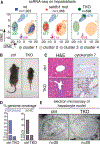H3K9me3-heterochromatin loss at protein-coding genes enables developmental lineage specification
- PMID: 30606806
- PMCID: PMC6664818
- DOI: 10.1126/science.aau0583
H3K9me3-heterochromatin loss at protein-coding genes enables developmental lineage specification
Abstract
Gene silencing by chromatin compaction is integral to establishing and maintaining cell fates. Trimethylated histone 3 lysine 9 (H3K9me3)-marked heterochromatin is reduced in embryonic stem cells compared to differentiated cells. However, the establishment and dynamics of closed regions of chromatin at protein-coding genes, in embryologic development, remain elusive. We developed an antibody-independent method to isolate and map compacted heterochromatin from low-cell number samples. We discovered high levels of compacted heterochromatin, H3K9me3-decorated, at protein-coding genes in early, uncommitted cells at the germ-layer stage, undergoing profound rearrangements and reduction upon differentiation, concomitant with cell type-specific gene expression. Perturbation of the three H3K9me3-related methyltransferases revealed a pivotal role for H3K9me3 heterochromatin during lineage commitment at the onset of organogenesis and for lineage fidelity maintenance.
Copyright © 2019 The Authors, some rights reserved; exclusive licensee American Association for the Advancement of Science. No claim to original U.S. Government Works.
Figures




References
-
- Duboule D, Dev. Suppl, 135–142 (1994). - PubMed
-
- Raff RA, The Shape of Life: Genes, Development, and the Evolution of Animal Form (University of Chicago Press, IL, 1996).
-
- Irie N, Kuratani S, Development 141, 4649–4655 (2014). - PubMed
-
- Meshorer E, Misteli T, Nat. Rev. Mol. Cell Biol. 7, 540–546 (2006). - PubMed
Publication types
MeSH terms
Substances
Grants and funding
LinkOut - more resources
Full Text Sources
Other Literature Sources
Molecular Biology Databases
Research Materials

